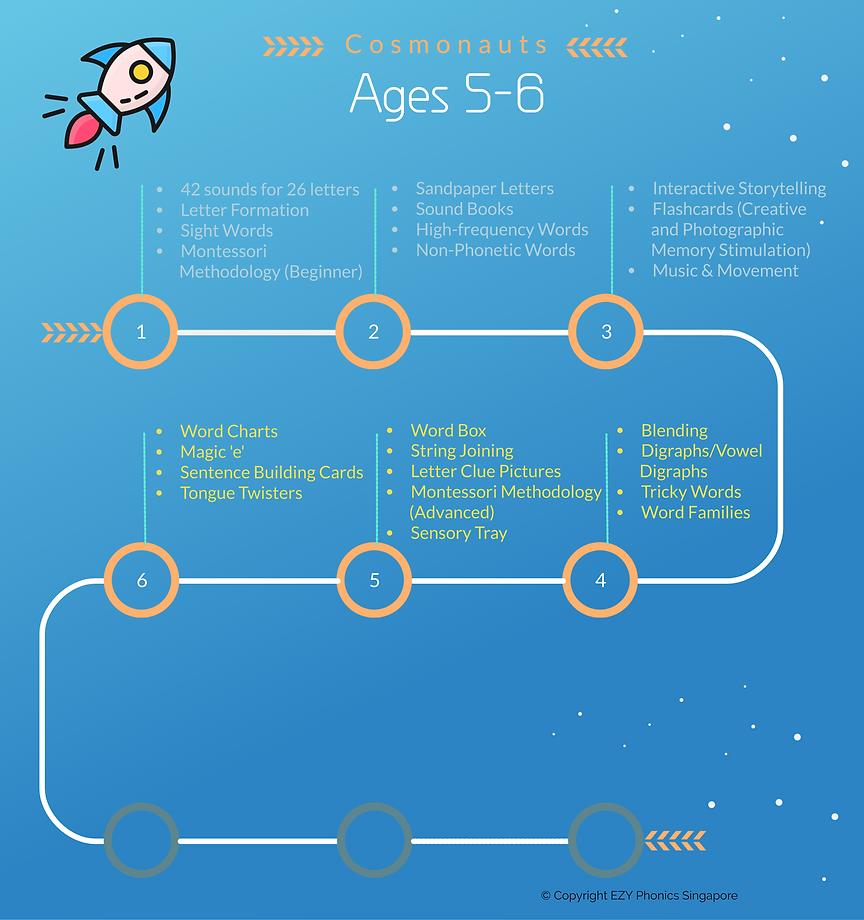Our Cosmonauts (Age 5)
.png)
The Cosmonauts-level targets children at their intermediate level of early English literacy development. At this level, our Explorers are introduced to a variety of additional concepts and techniques that fundamentally boost their language competency. By mastery of these concepts and techniques, our Explorers become ever more independent and confident, which naturally increases the joy of reading and expression. Children have variations in their ability to learn, but the requirements for reading are not different. We cater to every child at their individual rate of learning. Here's how we develop our Cosmonauts:
-
Word Charts
The creative use of Word Charts has many literacy benefits. Word charts aid children to make the connection between spoken and written words. We utilize a variety of Word Charts to help our Young Explorers learn crucial literacy skills.
-
Magic 'e'
Silent 'e' words, or sometimes called Magic 'e' words, can often confuse new readers. At EZY Phonics, we use Fold and Read cards, Four-in-a-Row games and Magic 'e' worksheets to seamlessly guide our Explorers.
-
Sentence Building Cards
Sentence Building Cards help children to physically arrange the order of their sentences and provide them with the opportunity to experiment with different possibilities and are particularly helpful for children who are at their intermediate stage of learning English.
-
Tongue Twisters
Tongue Twisters provide an easy and fun way to nurture interest in language development and we use lots of them to invoke curiosity and expression linking.


-
Word Boxes
In a nutshell, phonics is the mapping of the sounds of speech to the symbols of the alphabet. Word boxes is a methodology that can strengthen essential phonics skills in children.
-
String Joining
We equip our Cosmonauts with an assortment of techniques, guiding them to learn and remember the sound and its formation. With String Joining, our Explorers are introduced to common letter strings (eg. str; ing; ght) and are taught to establish distinct words with them.
-
Tricky & Non-Phonetic Words
Some words in the English language are particularly difficult for students to spell and interpret. In this level of teaching, we use a variety of teaching techniques to help our Cosmonauts which include Word Walls, Mnemonics and Word Families.
-
Interactive Storytelling (Intermediate)
We develop our Cosmonauts to become fluent readers by helping them understand what they read. At this level, beyond listening to captivating stories, they are encouraged to discuss what happens in them and are then guided to express an alternate narrative.
-
Blending and Segmenting
Children who can segment and blend sounds easily are able to use this knowledge when reading and spelling. Developing a child's blending ability is an important part of developing a reader. Many research studies indicate that children who have weak blending abilities also have weak reading and articulation skills. We progressively begin at the sentence level, moving to syllable, and finally to individual phonemes.

-
Digraphs/Vowel Digraphs
Although we introduce consonant digraphs at Starlings level, we further strengthen from this foundation at this stage. For example, the words pay, aim, grey all have the same /ai/ sound but they use a different digraph in each word. We use visuals and hands-on activities to help our Cosmonauts start to make deeper sense of this.
